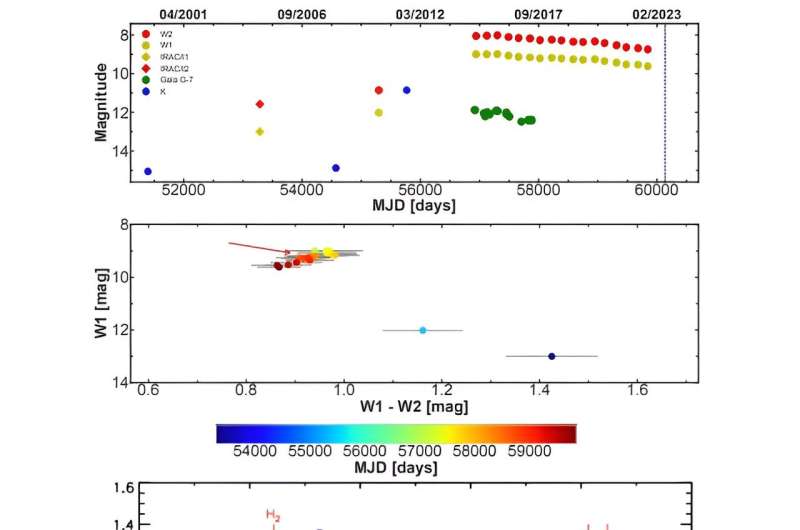December 7, 2023 report
This article has been reviewed according to Science X's editorial process and policies. Editors have highlighted the following attributes while ensuring the content's credibility:
fact-checked
trusted source
proofread
Four eruptive young stellar objects discovered

By analyzing the data from the SPICY catalog and from NASA's WISE spacecraft, an international team of astronomers has discovered four new eruptive young stellar objects (YSOs). The finding was presented in a research paper published in the December issue of the Journal of the Korean Astronomical Society (JKAS).
In general, YSOs are stars in early stages of evolution, in particular, protostars and pre-main sequence (PMS) stars. They are usually detected within dense molecular clusters, which are abundant in molecular gas and interstellar particles.
Observations show that episodic accretion processes occur in YSOs, therefore these objects may experience accretion-driven outbursts. Astronomers usually divide such events into EX Lup (also known as EXors) and FU Ori outbursts (or FUors). EXors are a few magnitudes in amplitude, and last from a few months to one or two years; FUors are more extreme and rare, can be up to 5 to 6 magnitudes in amplitude and last from decades to even centuries.
Given that eruptive young stellar objects are still a rare find and only a few dozen of such objects have been identified, a group of astronomers led by Carlos Contreras Peña of the Seoul National University, South Korea, has conducted a search for new outbursting YSOs. For this purpose, they combed through the data from the Spitzer/IRAC Candidate YSO (SPICY) catalog for the inner Galactic midplane and analyzed mid-infrared photometry from the Wide-field Infrared Survey Explorer (WISE).
As a result, the researchers identified four eruptive YSOs, namely: SPICY 97855, SPICY 99341, SPICY 100587 and SPICY 109331. SPICY 99341 and SPICY 100587 were classified as bonafide FUors, while SPICY 97855 is a candidate FUor, given that its final classification is uncertain as its outburst is still ongoing.
"We find four YSOs that show similarities to the spectra of known eruptive YSOs," the scientists wrote in the paper.
When it comes to SPICY 109331, its initial classification was EXor. However, the data suggest that the duration of its outburst is about five years, which is longer than the expectation for EXors. All in all, SPICY 109331 was classified as V1647 Ori-like source—a class between EXors and FUors, showcasing mixed characteristics.
According to the study, all the newly-found eruptive YSOs show long-term (lasting than one year), high amplitude (over 2.5 mag) outbursts. They also display strong 12CO emission lines in their spectra. These findings indicate that the four YSOs experience outbursts due to large changes in the accretion rate.
The study also found that SPICY 99341 and SPICY 109331 are located some 9,800 and 12,500 light years away, respectively. The distance to the other two YSOs is still uncertain and requires further observations.
More information: Carlos Contreras Peña et al., New Eruptive YSOs from SPICY and WISE, Journal of the Korean Astronomical Society (2023). DOI: 10.5303/JKAS.2023.56.2.253.
© 2023 Science X Network


















